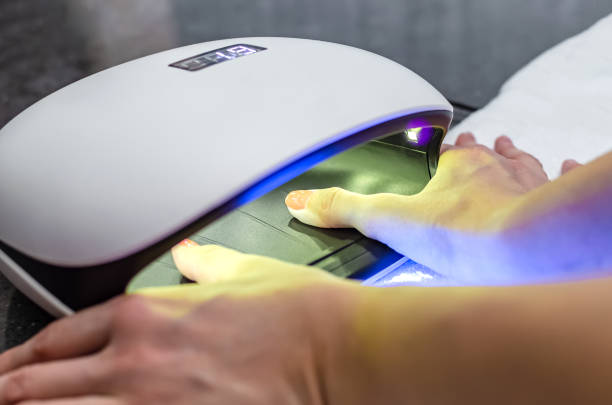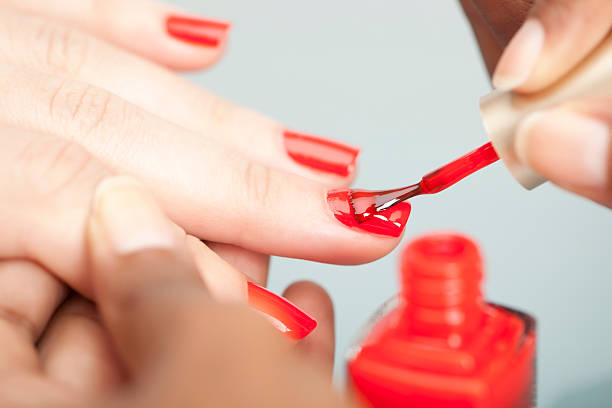Stepping into the vibrant realm of gel manicures, the wattage of your nail lamp is more than just a number—it’s an unseen force that shapes the final masterpiece that is your nails. The right wattage ensures a perfect cure and transforms a simple layer of gel into a resilient, glossy shield of color that withstands daily life. This guide will shine a light on an often-overlooked aspect of the process: “How many watts should a gel nail lamp be?” We’ll delve into the role of wattage in the curing time, the quality of your manicure, and how to navigate the sea of choices to find the right nail lamp for your needs.
Nail lamps are a marvel of technology, specially designed to emit light at specific wavelengths, which interacts with the gel polish to trigger a process called photopolymerization. This chemical reaction turns the liquid gel polish into a solid, durable coating on your nails.
There are two main types of nail lamps used in the industry: UV and LED. While they both serve the same purpose—to cure gel polish—they do so in slightly different ways. UV lamps emit a broad spectrum of UV light, while LED lamps emit light at a narrower, more specific range of wavelengths. You can learn more about this topic in our other article: Does A UV Lamp Dry Regular Nail Polish?

Wattage is a common term you’ll encounter in the context of nail lamps. Simply put, wattage is a measure of electrical power, indicating the amount of energy the lamp uses to produce light. The wattage of a nail lamp significantly impacts the curing process. A higher wattage lamp will produce more light energy, curing gel polish faster, which is why professional nail salons often use high-wattage lamps.
However, more wattage doesn’t always equate to better results. While a high-wattage lamp can cure gel polish faster, it can also generate more heat, leading to a sensation known as “heat spikes”, which can be uncomfortable for some people.
The optimal wattage for a gel nail lamp varies depending on several factors:
1. Type of Gel Polish and Application Layers: Each layer in the process of applying gel polish may require different wattages and curing times.
Colored Gel Polish: This is the layer where you apply the color of your choice. Depending on the color’s opacity, you might need to apply two to three coats, curing each coat separately. Darker colors or glitter polishes may require a longer curing time due to their density.
Top Coat: This is the final layer applied. It gives your nails a glossy finish and protects the colored polish from chipping or peeling. The top coat may require a longer curing time to ensure it’s fully set and hard.
It’s crucial to understand the specific requirements of each layer and adjust your lamp settings accordingly. Always check the manufacturer’s instructions for the recommended wattage.

2. Professional or Home Use: High-wattage lamps (36 watts and above) are preferred for professional nail salons as they allow for quicker service. However, for home use, a lower wattage lamp (around 24 watts) is usually sufficient and more affordable.
3. Comfort: Higher wattage lamps can generate more heat, which can lead to uncomfortable heat spikes. If you’re sensitive to heat, you might want to opt for a lower wattage lamp or a lamp with a low-heat mode.
4. LED vs UV Lamps: LED lamps generally require less wattage than UV lamps to cure gel polish, thanks to their more targeted range of wavelengths. A 12-watt LED lamp can be as effective as a 36-watt UV lamp.
5. Lamp Beads and Area of Exposure: The number of lamp beads and their arrangement is another important aspect to consider. A higher wattage can cover a larger area, but a well-arranged lamp can provide an all-round, uniform exposure to the nail surface.
Choosing the wrong wattage can negatively affect your manicure. A too low wattage may not fully cure the gel polish, resulting in a manicure that is soft, sticky, or easily smudged. Conversely, too high wattage can overcure the polish, leading to brittleness, discoloration, or a tendency to lift from the nail. Overcuring can also generate excessive heat, which can be uncomfortable or even harmful to the skin.
The wattage of your nail lamp is your trusty compass in the colorful world of gel manicures, guiding you towards the perfect, glossy finish. It’s about striking the right balance between curing efficiency and comfort, ensuring your manicures are not only visually stunning but also durable, safe, and kind to your nails.
So, when you switch on your nail lamp, remember – you’re not just powering a device; you’re paving your path to fabulous, long-lasting manicures. Here’s to beautiful nails, the right wattage, and the magic of gel manicures!
16 Years
Experience
12 Months
Warranty
Monday - Sunday
24/7 Customer Support
Be the first to know about special offers, new innovations and more.